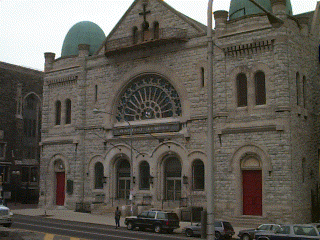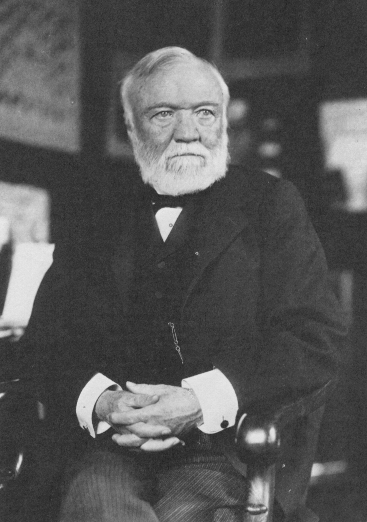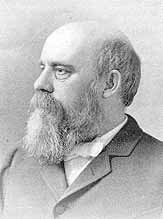|
THE SOCIAL GOSPEL Religion and politics make strange bedfellows, but the late 1800s saw that very relationship. American Protestantism became indistinguishable from American democracy and capitalism. It is the purpose of this page to note the results of this social and religious identity. I. The Gospel of Wealth American capitalism spawned a generation which emphasized "big business" with a corresponding growth of giant corporations, monopolies, and moneyed families. American Protestantism contributed to this atmosphere through its inference that wealth marks those whom God blesses. In other words, the true believer is an American and wealthy. Russell Conwell (1843-1925) illustrated this trend. An officer during the Civil War, Conwell practiced law and was an editor before becoming a Baptist preacher in Philadelphia. Conwell built a sizeable congregation at Temple Baptist Church (pictured below).  He is best known, however, for his lecture "Acres of Diamonds." Over a 20 year period Conwell delivered this lecture at least 6,000 times. The lectures, and the sale of a small book on the subject, netted Conwell some $8 million in revenues. "Acres of Diamonds" suggests the individual must develop that which is immediately at hand. Conwell's illustrations included those who grasped at the opportunities at hand and made the best of them. In the process he said, "Get rich! God wants you to be rich!" In fact, Conwell said the Christian's duty includes amassing wealth. He is best known, however, for his lecture "Acres of Diamonds." Over a 20 year period Conwell delivered this lecture at least 6,000 times. The lectures, and the sale of a small book on the subject, netted Conwell some $8 million in revenues. "Acres of Diamonds" suggests the individual must develop that which is immediately at hand. Conwell's illustrations included those who grasped at the opportunities at hand and made the best of them. In the process he said, "Get rich! God wants you to be rich!" In fact, Conwell said the Christian's duty includes amassing wealth.
To Conwell's credit, he put the $8 million he earned into philanthropic ventures keeping nothing for himself. Best known are the extensions of Temple Baptist Church: Temple University and Temple Hospital. Historians call the late 1800s the "age of enterprise." It is the age of the "captains of industry," the Rockefellers, Vanderbilts, and the Astors. John D. Rockefeller gained his wealth through the development of the Standard Oil Company. As a good Baptist, Rockefeller believed in Christian stewardship so he gave generously to various charities. One of his major recipients was the University of Chicago to which he gave over $43 million. Andrew Carnegie (1835-1919) best exemplifies the merger of Christianity and capitalism. An immigrant, Carnegie represents the reality of American opportunity. Anyone can become wealthy in America. In a magazine article entitled "The Gospel of Wealth," Carnegie said you can do only three things with personal wealth: (1) You can let your heirs get it. (2) You can let the government get it. (3) You can give it away. Carnegie opted for the third option. His reason? (1) Those who do not earn wealth do not know how to use it. (2) Allowing the government to get the wealth is inefficient. (3) By elimination only the third option remains. The "gospel of wealth" impacts the churches. By the late 1800s, churches felt the increased substance of their members. They used their wealth to erect finer and finer buildings. Those with less income, less prestige, less social standing begin feeling out of place. Churches were obviously becoming largely middle and upper class groups. This led to social dissatisfaction--a result of the homogeneous principle at work. Furthermore, wealthy congregations called better educated preachers to their pulpits. These preachers tended to come from Liberal seminaries. Doctrinal tension also resulted. II. Doctrinal dissatisfaction Sociological factors play an important part in Christianity. Those in lower social strata looked closely at their wealthier brethren. They directed their greatest attention to doctrinal issues. How does one criticize another's wealth without sounding jealous? Doctrinal issues, however, are another story. Protestant denominations traditionally emphasized holiness or Christian character. As affluence grew the stress on holy living seemed to decrease. Methodists offer a prime example. John Wesley accentuated preaching to the poor. Over the years American Methodists experienced "redemption and lift."(1) In time the poor felt uncomfortable with mainline Methodism. For them it became easy to criticize their brethren for a lack of "true conviction." In fact, Methodism became the focus for reaction. Methodists experienced division over "holiness" issues long before the "age of enterprise." Michigan Methodists pulled away to form the Free Methodist Church in 1859. The issue: slavery! After the Civil War other Methodists formed the National Camp Meeting for the Promotion of Holiness in 1867. Like the Methodists, the camp meeting promoted perfectionism and holiness. Several Methodist bishops and the presidents of two Methodist schools, Drew Seminary and Syracuse University, supported the camp meeting. "Camp Meeting Methodists" soon called other Methodists to "come out" from less spiritual congregations. By 1888 the camp meeting supported 206 full time evangelists. In general, the 1880s saw a holiness revival. In 1885 the first General Holiness Association met in Chicago. The Church of the Nazarene grew out of this and other similar meetings and was first known as the Pentecostal Church of the Nazarene. By 1907 the denomination dropped the designation Pentecostal. This same reaction to perceived spiritual deadness also led to the beginnings of true Pentecostalism. About 1900, Charles F. Parham taught students at Topeka's Bethel College about Holy Spirit baptism. Some students began speaking in tongues. Many of these students left Topeka taking the doctrine of the baptism of the Holy Spirit as manifested in charismatic gifts throughout the south, particularly Texas. One of Parham's converts went to Los Angeles where, in 1906, a Pentecostal revival broke out in a black church on Azuza Street. Early Pentecostals maintained they did not want to start a new denomination but sought only to call all Christians back to the primitive apostolic faith. In Cleveland, Tennessee, A.J. Tomlinson received the baptism of the Holy Spirit in 1908. A whole new wave of Pentecostalism swept forth from Cleveland. Today there are five denominations all called The Church of God, and all charismatic, which have headquarters in Cleveland. Throughout the United States there are some 200 groups with the same name; 44 trace back to Tomlinson. Another major group which arose from the Pentecostal Movement is the Assemblies of God. Originally a number of different Pentecostal bodies, this new denomination formed in Hot Springs, Arkansas, in 1914 III. The Social gospel Holiness and Pentecostal groups reflected a reaction to mainline Protestantism's affluence and Liberalism. From the mainline bodies, however, came a new emphasis: the social gospel. The social gospel grew out of the Liberals' incurable optimism. After all, man was the master of his own destiny; man could improve his lot in life. No one used the term "social gospel" prior to 1900. Those who developed the social gospel referred to it as "social Christianity." Historians differ about the period's dates, but most date it as 1870-1918. The social gospel responds to the needs of the industrial revolution and is defined as "the application of the teaching of Christ and the total message of salvation to society, the economic and social institutions as well as to individuals." Social gospelers identified three major societal problems: (1) Business competition. (2) Labor-management relations. (3) Urban difficulties. The social gospel is a middle American attempt to ease the plight of the poor, most of whom do not attend any church. Matthew 25 became their main Scriptural frame of reference. A number of contemporary circumstances promote the social gospel's development. In each circumstance it appeared no one demonstrated much concern for the workingman. Industries laid off thousands of workers during the Panic of 1873. How could urban workers provide food, heat, and shelter for their families without work? No one seemed to care. In 1877, workers began a series of nasty strikes. Clergymen opposed the strikes when they began, but by 1886, many show open sympathy. Unfortunately the strikes degenerated into violence and property destruction. When violence raged any sympathy for the strikers melted away. In 1887, strikers riot in the Haymarket Riot in Chicago. Several anarchists spoke openly during the strike. When police moved in a bomb exploded killing 12 policemen. The authorities apprehended several of the anarchists who were ultimately tried and found guilty. The churches openly approved their death sentence. More strikes followed including those during the Panic of 1893 and the more widely known Railway Workers' Strike in 1894. By then, however, the churches and the clergy had once again become sympathetic to the workingman's plight. In 1894, Protestant Churches formed the Institutional Church League to meet the needs of the cities. The institutional church provided gymnasiums, athletic programs, lending libraries, sewing classes, lecture rooms, English courses and youth centers. At the same time, the churches sought improvement in the urban standard of living. Salary increases obviously result in an improved living standard. The churches reasoned that wages remained low because immigration continued to supply a cheap labor source. Cut off immigration and you reduce the labor pool forcing wages up. Liberals applied pressure and the government shut off immigration in 1924. It worked. Supply and demand drove wages up. It is interesting to note that today liberals insist white bigotry led to the limitation on immigration. By the 1890s, Liberals emphasized the Kingdom of God. Liberals believed they could usher in the Kingdom of God because Christians were engaged in developing God's kingdom on earth. An evidence of this whole concept is Charles Sheldon's book, In His Steps. Written in 1906, In His Steps said all social problems could be solved by asking one simple question, "What would Jesus do?" Social gospelers covered a wide spectrum from conservative to radical. Joseph Cook illustrates the conservative social gospelers. He says you can alleviate the problems of the poor through voluntary reform. Conservative social gospelers were often paternalistic but believed the government should stay out. The best solutions came from the "private sector" through the application of the principles of "the gospel of wealth."
Iowa's George Herron (1862-1925) best represents the radical element. Herron taught at Grinnell College in Grinnell, Iowa. He joined the Socialist Party in America and advocated radical solutions to America's social problems. Herron's personal life reduced his influence, however. A wealthy Grinnell widow backed Herron financially. Evidently this widow had a young daughter. Herron divorced his wife and married the young woman creating quite a scandal in socially proper Grinnell. World War I ends both the social gospel and the progressive era. In some ways it was a magnificent period. Men believed with great confidence that they could solve man's social problems and create an earthly utopia. It was the period the "Gay 90s"--which weren't so gay--and optimism. Behind the scenes, however, were the seeds of disillusionment and despair. World War I simply brought those seeds to full fruit. __________________ 1. "Redemption and lift" is that principle which states that Christianity always results, over time, in bettering the believer's social standing. It often takes more than one generation, but those congregations which started out successfully reaching the poor ultimately become more affluent and successful. Economic improvement obviously came about as individuals practiced principles of Christian stewardship and, because of faith, developed the confidence to risk. Such people often improve their lot in life. |
 Carnegie began working menial jobs as a lad saving money as he could. Someone challenged him to invest money in a bridge-building company, which he did. Ultimately he became part of the company, then its president. He then bought a steel company which, in turn, was bought out by a conglomerate for a whopping $50 million. This new company eventually became united States Steel.
Carnegie began working menial jobs as a lad saving money as he could. Someone challenged him to invest money in a bridge-building company, which he did. Ultimately he became part of the company, then its president. He then bought a steel company which, in turn, was bought out by a conglomerate for a whopping $50 million. This new company eventually became united States Steel. Two important individuals provided leadership for the moderate social gospelers. Washington Gladden (1836-1918) was the first. A Congregational preacher in Columbus, Ohio, Gladden advocated labor's right to organize. He believed wrongs should be righted through love but also believed government needed to intervene at times. The second important leader is Walter Rauschenbusch (1861-1918) who was a German Baptist preacher and church history professor. Rauschenbusch's first ministry took place in a rough section of New York City known as "Hell's Kitchen." As he surveyed the city's problems he realized they couldn't be solved by conventional piety. For example, Rauschenbusch reported that one man was hit and seriously injured by a street car. He received $15 in compensation and was fired from his job. Moderates favored reform through government action. Rauschenbusch himself favored socialism but didn't push it. Most moderates preferred the title "Progressive" and their impact resulted in the "Progressive Era." Teddy Roosevelt and the Progressive Party (Bull Moose) typify the moderate social gospel agenda.
Two important individuals provided leadership for the moderate social gospelers. Washington Gladden (1836-1918) was the first. A Congregational preacher in Columbus, Ohio, Gladden advocated labor's right to organize. He believed wrongs should be righted through love but also believed government needed to intervene at times. The second important leader is Walter Rauschenbusch (1861-1918) who was a German Baptist preacher and church history professor. Rauschenbusch's first ministry took place in a rough section of New York City known as "Hell's Kitchen." As he surveyed the city's problems he realized they couldn't be solved by conventional piety. For example, Rauschenbusch reported that one man was hit and seriously injured by a street car. He received $15 in compensation and was fired from his job. Moderates favored reform through government action. Rauschenbusch himself favored socialism but didn't push it. Most moderates preferred the title "Progressive" and their impact resulted in the "Progressive Era." Teddy Roosevelt and the Progressive Party (Bull Moose) typify the moderate social gospel agenda.